
The Dramas of Haymarket. http://www.chicagohistory.org/dramas. Curator: Carl Smith, Northwestern University; Design and Director of Production: Jason Betke, Northwestern University, Research Coordinator: Melinda Spitzer, Chicago Historical Society; Software Creator: William Parod, Northwestern University; Assistants and Technical Support: Kay Yang, Lucas Hackett, Michael Cruz, Yuko Nagaki, Mark Schaefer, Dennis Glenn, John Norstad, Bruce Foster, Andrianna Kastanek, Brian Artese, and Robert Taylor, all from Northwestern University.
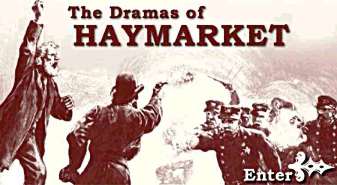 | |
Opening screen of The Dramas of Haymarket. |
|
The Haymarket Affair, of May 4, 1886, was
the most spectacular instance of peacetime violence in nineteenth century
America. The throwing of a bomb and the eventual death of seven police officers
during an anarchist meeting in Haymarket Square in Chicago, followed by
the trial of eight anarchists and execution of four (one committed suicide
and three others were imprisoned) highlighted the new prominence of the
labor question in American life. Today, labor and social historians understand
that Haymarket was actually a constituent part of the "great labor upheaval,"
a mass uprising of organized industrial workers against the oppressive conditions
of an early urban-industrial market society.
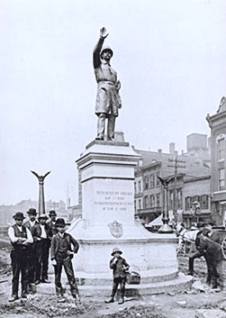 |
Statue erected in 1889 to honor
the seven police victims
of Haymarket. From Act V of
The Dramas of Haymarket. |
|
But, for previous generations Haymarket signified something different. To most civic leaders and the respectable classes in Gilded Age America, what was then called "the Haymarket Riot" was a horrifying instance of the dire threat posed by ignorant immigrants and the dangerous poor to republican liberty and the institutions of private property that guaranteed material progress. Hanging four anarchists for the murder of the police and the erecting a statue of a policeman in Haymarket Square seemed a just vindication of the precarious new social order then called "free labor" (the ability of wage workers to work their way up into propertied independence) that had just recently emerged from the fires of a national Civil War.[1]
Only beginning in the New Deal did Haymarket come to be recognized as a great tragedy, apotheosized in the execution of four men for a crime they did not commit. Especially for a generation of scholars emerging from 1950s McCarthyism, Haymarket was a spectacular civil liberties violation. It was the nation's first red scare, an example of what hysterical public opinion searching for scapegoats could do to the rights of innocent citizens.
As the generation that participated in the great social movements of the 1960s and 70s has come of age, a different view, also rooted in the nineteenth century, has come to the fore. Echoing the tradition maintained by the anarchist and radical left itself—that the hanged men were heroes and martyrs to a just revolutionary cause—this view reverses the valuation given Haymarket by the partisans of the free labor social order in the Gilded Age. It also challenges the view propagated by trade unionists that downplays anarchism and treats the anarchists as labor martyrs.
The Dramas of Haymarket is an aesthetically appealing site written and constructed under the direction of Carl Smith, Professor of American Studies and History at Northwestern University. The digitized documents available on the Web page are from the Haymarket and other related collections of the Chicago Historical Society. The site contains, according to its author, 270 Web pages, 325 separate images, over three dozen documents, and 185 individual interpretive and descriptive items. It is simply enormous in scope, far beyond what could be absorbed in a single visit or reading. It is a great tribute to the thoroughness of Prof. Smith, his associates, and the Chicago Historical Society.
As the plural title of the Web page indicates, Smith is well aware that Haymarket is a contested tradition. That is, it is a story that can be understood within several different dramatic narratives. As Smith puts it, it is a "drama without end," whose "last act will never be written." As Smith is also aware, his decision to treat Haymarket as a drama brings with it its own limitations and distortions. But first it is necessary to describe the Web page itself.
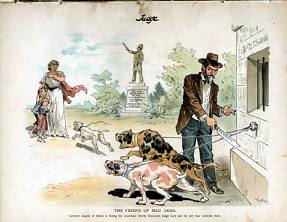 |
Cartoon reacting to the 1893 pardon by Governor John
Peter Altgeld. From The Dramas of Haymarket. |
|
Haymarket is constructed as a dramatic narrative proceeding in chronological order, consisting of a prologue, five acts and an epilogue. The Prologue entitled "Whither America" takes the viewer from the Great Fire of 1871 to 1880. Act. I, "Subterranean Fire" traces the rise of the anarchist movement from 1880 to 1886. Act II, "Let Your Tragedy Be Enacted Here" deals with the events of the three days of May leading up to the May 4 meeting. Act III, "Toils of the Law," covers the trial to the verdict. Act IV, "The Voice of the People," covers the period from the conviction to the execution of the anarchists on November 11, 1887. Act V, "Raising the Dead" deal with the period from the funeral to the pardon of those anarchists remaining in jail in 1893 by Governor John Peter Altgeld. The Prologue, "Drama Without End" deals with the way Haymarket has been treated by the public.
Clicking on an act page brings the viewer to approximately 750-1000 words of introductory text. On the left margins of each "act page" are section links that bring the viewer to one of a number of section pages. Each of these pages includes seven or eight images and related texts drawn from the collections of the Chicago Historical Society. For example, on the Prologue: Whither America? page, opposite the text,  |
The Declaration of Principles
of the Socialist Labor Party in 1879.
From The Dramas of Haymarket. |
|
are four sections entitled "Phoenix City," (rebuilding Chicago after the Fire); "Summer of 1877" (the Great Railroad Strike of 1877); "The Lines are Drawn" (repercussions and commemorations of 1877), and "From the Archive" (miscellaneous documents). Clicking on the image of "The Lines are Drawn" brings the viewer to eight different images with titles. Clicking on an image titled "Alternative America" brings up a broadside, "The Declaration of Principles of the Socialist Labor Party in 1879," which one can be enlarged by clicking on the image. Beside the image are four paragraphs of text. The text describes the broadside's origins, quotes from its preamble to summarize its contents, highlights several planks, and then relates how the use of fraud to keep a socialist alderman from taking his seat led one of the anarchist martyrs, Albert Parsons, to despair of reform within Chicago's political system.
Many of the documents and especially the images are well known to those familiar with Haymarket,. But there are a number of notable documents that deserve mention. The Web site reproduces in its entirety the1893 pardon message of Altgeld. There are three extended discussions of the role in Haymarket of Police Captain Michael Shaack that enrich the story. For example, we learn that in his book Shaack admitted he inflated the anarchist threat; later we find that in 1889 both Shaack and Bonfield were dismissed from the force by the mayor for abuse of power, a partial vindication of the anarchist defendants. There is also excellent material on Lucy Parsons, the wife of Albert, who kept the martyr's flame alive into the mid-twentieth century. A special treat (see Epilogue: Drama Without End) are short video and audio clips of Studs Terkel, Les Orear of the Illinois Labor History Society, and descendants of a police officer slain at Haymarket and an anarchist pardoned by Altgeld.
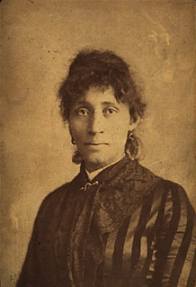 |
Lucy Parsons as a young woman.
From The Dramas of Haymarket. |
|
One minor problem that arises after viewing images and reading their extended captions is that the viewer loses track of their location. For example, the Shaack material is separated into three different entries located in two different acts. The same is the case with other key individuals. Someone who was already familiar with the Haymarket story and just wanted to glean material about Lucy Parsons or anarchist movement culture would have to slog through eact act and each section page in order to find the material. A Site Map exists, but is not easily accessible to the viewer.
There is a more serious drawback to The Drama of Haymarket. Despite the fact that the project director is aware that there is more than one narrative structuring the meaning of Haymarket, he largely neglects other narratives. For example, we never get a sympathetic feel for the thinking of those who, from the point of view of America's republican civil religion, feared and rejected the anarchists. If we did, we might learn how much the anarchists and the forces of order had in common, notwithstanding obvious differences. Both sides counterposed a "natural liberty" to "slavery"; each viewed the other from within the confines of a drama pitting virtue against corruption; and both sides believed in conspiracies against individual liberty.
More to the point, both narratives had difficulty in making sense of a dynamic industrial market society in which individual property ownership was less and less the sine qua non of personal freedom. Thus, leading Chicago reformer Henry Demarest Lloyd called anarchism "the fag end of the system of perfect freedom for the individual initiative, which was breaking down." Thorstein Veblen also viewed anarchism as part of an eighteenth century "metaphysic."[3]
 |
Masthead of The Socialist, a Chicago radical paper
published in the 1870s. From The Dramas of Haymarket.. |
|
But these were not the only narratives. Indeed, the attempt to frame a drama based on either of these dramatic narratives reinforces a dichotomous, good/bad understanding of Haymarket. A different narrative—the narrative of evolving democracy, though far less dramatic or compelling and yielding no martyrs—could have contextualized both dramatic narratives. The democratic narrative would note that the electoral decline of socialism in the early 1880s was due not to electoral fraud, but to Mayor Carter Harrison guaranteeing freedom of assembly to German socialists and their movement culture of picnics, singing societies, holiday demonstrations, and militias. During this period, large numbers of German socialists were integrated into the Democratic Party. Only the breakdown of the ruling Democratic coalition produced the conditions that led to Haymarket. By 1888 that coalition had resumed its hegemony in the city based on the party's deepened support for trade unionism (the eight hour day for city and county workers and no police interference in strikes) and an early form progressive political reform.[4]
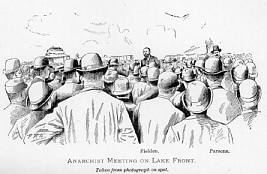 |
Meeting of Anarchists.
From The Dramas of Haymarket. |
|
A democratic narrative would also note that following Haymarket, key anarchist leaders switched their allegiance from anarchist politics to the American Federation of Labor. Anarchist carpenters (the single largest occupational group represented in the Chicago anarchists) rejoined the United Brotherhood of Carpenters and Joiners in 1887 and took with them their commitment to militance and labor solidarity. Dyer Lum, ex-editor of the anarchist paper The Alarm, began writing for the American Federation of Labor in the 1890s. Lum contended that increased discipline and organization of the forces of labor supplied by unions would evolve society toward "voluntary association" in which labor would "step into the market and contract for itself." In the first decade of the twentieth century the syndicalist William Z. Foster, who operated out of Lucy Parsons' home, also worked within the spacious confines of AFL unionism. Foster's belief that militant trade unionism with minimal political intervention would lead to revolution originated in his association with Jay Fox, a Chicago anarcho-syndicalist.[5] In short, Chicago anarchism turned out to be a contributor to the left wing of the country's democratic trade union tradition as well as an alternative to it.
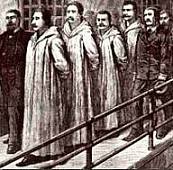 |
The death march of the convicted.
From The Dramas of Haymarket. |
|
The Dramas of Haymarket will continue to fascinate, inspire, and instruct generations to come. Historians will continue to debate and reinterpret it. The Web site "Drama of Haymarket" is doubtless the best introduction on the internet available to the subject and to the relevant collections of the Chicago Historical Society. It is eminently suitable for those requiring an introduction to the topic: the general public, high school teachers and their students, and college undergraduates. However, for a critical and contextualized understanding, it should be supplemented by additional historical works, many of which are listed on the Web site.
Richard Schneirov
Indiana State University
NOTES:
-
Eric Foner, "New Introduction" Free Soil, Free Labor, Free Men: The Ideology of the Republican Party before the Civil War (1970; reprint, New York: Oxford University Press, 1995); see also Ray Ginger, Altgeld's America: The Lincoln Ideal versus Changing Realities (1958; reprint, Chicago Quadrangle Books, 1965).
[Return]
- Henry David, The History of the Haymarket Affair (New York: Farrar and Rinehart, 1936); Harry Barnard, Eagle Forgotten: The Life of John Peter Altgeld (1938; reprint, Secaucus, N.J.: Lyle Stuart, 1973).(June 1917).
[Return]
- Lloyd quoted in Caroline Augusta Lloyd, Henry Demarest Lloyd, 1847-1903 (New York: G. P. Putnam's Sons, 1912), I:96; Thorstein Veblen, The Theory of Business Enterprise (1904; reprint, New York: Mentor Books, 1963)., 144-76.
[Return]
- Richard Schneirov, Labor and Urban Politics: Class Conflict and the Origins of Modern Liberalism in Chicago, 1864-1897 (Urbana: University of Illinois Press, 1998).
[Return]
- Richard Schneirov and Thomas J. Suhrbur, Union Brortherhood, Union Town: The History of the Carpenters' Union of Chicago, 1863-1987 (Carbondale: Southern Illinois University Press, 1988), 25, 31-34; Dyer D. Lum, The Philosophy of Trade Unions (New York: American Federation of Labor, 1892); Edward P. Johanningsmeier, Forging American Communism: The Life of William Z. Foster (Princeton: Princeton University Press, 1994), 53-54, 157.
[Return]
~ End ~
Web Site Review of The Dramas of Haymarket
Copyright © 2000, 2001 by The Journal for MultiMedia
History
Comments
| JMMH
Contents
|







